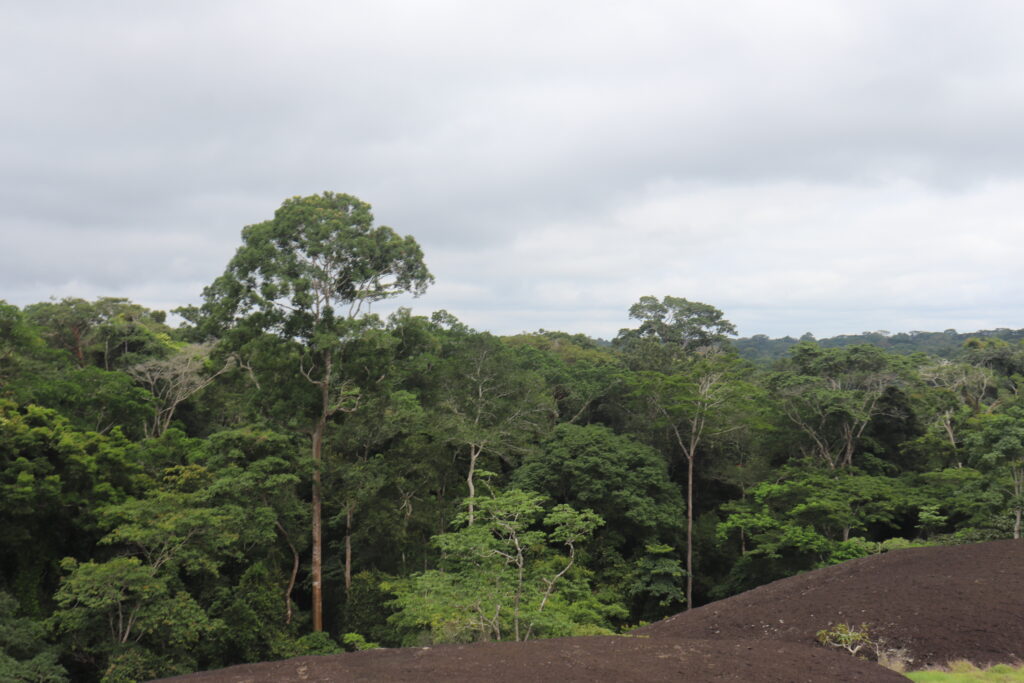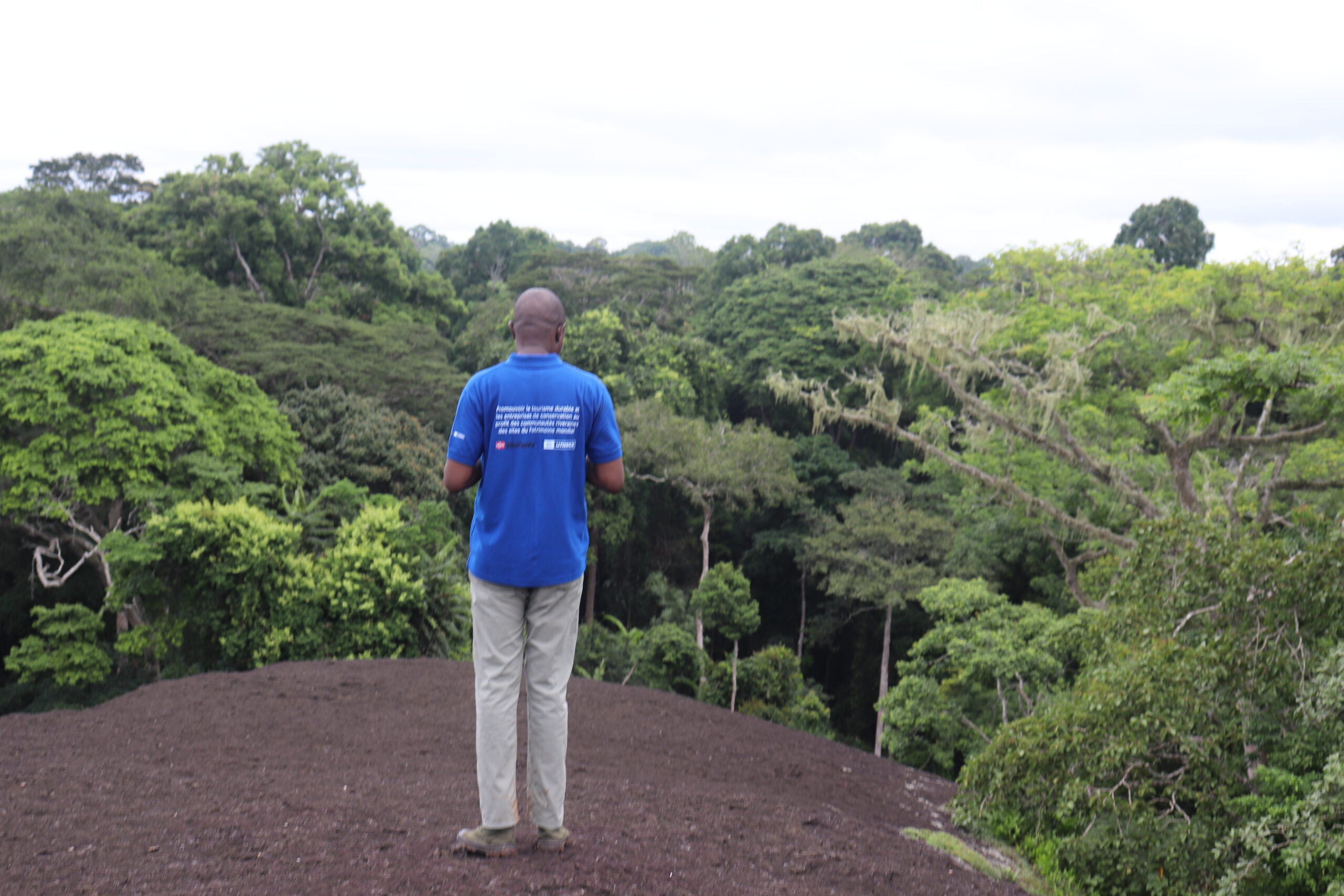By Leocadia Bongben
Look, there is no fuse about the Dja Biosphere Reserve.
And that is the way it should be.
Indigenous Baka communities live on the fringes of the Dja Biosphere Reserve. Most people around the Biosphere Reserve are farmers and hunters.
You can access the Biosphere Reserve from any of these four access areas: Somalomou in the north, Lomie in the east, Meyomessala in the west, and Djoum in the south.
The Dja Biosphere is regaining its normal status as a reserve under observation. There have been threats to the Biosphere Reserve, and management has had to provide a progress report every two years.

The Faunal Reserve, the Biosphere Reserve
You wanted to understand why it is wrong to say that the Dja Faunal Reserve is also the Biosphere Reserve.
Mohamadou is the sub-director of protected areas at the Ministry of Forestry and Wildlife and doubles as the focal point of the National Committee on Man and the Biosphere; he understands the language of reserves.
“The Dja Faunal Reserve is the central area of the Dja Biosphere Reserve. The buffer zone and transition area form part of the Dja Biosphere Reserve, “Mohamadou explains.
The program on ‘Man and the Biosphere, MAP under which the biosphere reserve is integrated into the world network, and its status as a heritage site under the Convention on the Protection of World, Cultural, and Natural Heritage of November 16, 1972, are the two governing instruments of the Dja Biosphere Reserve piloted by UNESCO.
UNESCO threatened to include the Dja Reserve on the UNESCO red list of World Heritage sites in danger. Many have interpreted this to mean poor relations between Cameroon and UNESCO.
Mohamadou explains that Cameroon maintains an obligatory and cordial relationship with UNESCO through the Ministry of Forestry and Wildlife.

“The relationship is that of advice, early warning, and information sharing to preserve the two statutes managed at the level of UNESCO. Cameroon, under the MAP programme has the leeway to manage applications and students’ admission, which is a mark of sincerity and trust. UNESCO elaborates many projects in collaboration with the Ministry of Forestry and Wildlife to support the Biosphere Reserve, whether it concerns its status as a heritage site or biosphere reserve,“ Mohamadou states.
Cameroon has five biosphere reserves. As a mark of sincerity and confidence, Dumbarey in 2022 and Korupt Tropical Forest in 2023 gained their status as biospheres. UNESCO supports actions at the site concerning the MAP program by mobilizing funds.
The convention on biosphere sites is static, and there are guidelines for implementation. A country must conduct an impact assessment study and submit it to the World Heritage Center before work commences on a project of universal value.
Two activities are not negotiable. Within the Biosphere Reserve, oil and gas exploration is prohibited, and activities are carried out in collaboration with the World Heritage Center secretariat. Paragraphs 172 and 174 of the guidelines specify that the World Heritage Center only intervenes when oil and gas exploitation is not concerned.
Man and Biosphere
MAP is a scientific intergovernmental program that seeks to stimulate sustainable development. The program started in 1971 with the realization that conservation without Man was not a good option. Man is central to conservation and should cater to socio-economic and social development needs.
In the Dja Biosphere Reserve, management opted for zoning to ensure indigenous communities are part of the conservation. The central area is dedicated to conservation, while the buffer zone offers protection and the transition provides logistic support, so all activities can be carried out.
The governance structure of the MAP program includes, at the highest level, the MAP International Coordination Council, composed of 34 states chosen at the UNESCO General Conference. Then, follows the MAP Secretariat, supported by the UNESCO Division of Ecological Sciences and Land. There are MAP National Committees, and lastly, there are biosphere reserves. This is the status.
Regarding the integration proposal in the World Biosphere Reserve Network, there is another consultative body, the International Consultative Council on Biosphere Reserves. This body provides opinions on the files transmitted so that the International Coordination Committee can make its decision regarding registration, deferring, rejecting, and based on analysis. Concerning MAP’s operation, UNESCO National Commissions make decisions in countries without MAP National Committees.
Some people tend to define, compare, or even believe the biosphere reserve is a protected region. No. Although the Dja Biosphere Reserve has protected areas, it is not a protected area per se.
The framework of the Convention on the Protection of World Cultural and Natural Heritage Sites guidelines requires that a site be evaluated every 10 years. The remote monitoring process was activated for the Hydro-Mekin power project, which was perceived as a threat. The Hydro-Mekin project was modified. The population was relocated, and other corrective measures, like a reduction in the size of the agro-industry (Sudcam), were implemented.
More about the Dja Biosphere Reserve
Schouam village is one of the entrances to the Dja Faunal Reserve. You will trek for four hours in the forest to the top of the giant rock.
The rock’s spectacular view of the Dja Faunal Reserve, the central part of the Biosphere Reserve, is above 500 hectares of intact forest. Schouam Rock is a tourist site that has yet to attain its full potential.
Schouam villagers claim their lives are connected to the rock, as seen in a tradition passed down from the ancestors. The story goes that any male child born in Schouam village is immediately taken to the rock. The gods fortify and the child is brought back home after three days.
Bifalone Village

Baka Village communities live on the fringes of the Dja Biosphere Reserve, and Bifalone, with 430 people, is one of them.
Temboleu, the chief of Bifalone, says the hospital is seven kilometers from the village. Without money, access to healthcare here is limited.
There is a change. Bakas people in Bifalone no longer rely solely on herbs from the forest to cure malaria, headaches, and stomachaches. “There are serious ailments for which we must go to the hospital. Women in Bifalone go to the hospital for safe delivery and to vaccinate their children.”
Bifalone village, as a member of the Biosphere Reserve, contributes to the fight against poaching.
Temboleu says, “Baka people around the reserve should be compensated to continue preserving the forest. Our children need to go to school to become successful.”
Baka women now work with non-timber forest products (NFTP). This village is embracing change, and the chief, a father to 10 children who started a two-hectare cocoa farm, has seen a slight increase in yield. He hopes the cooperative will help them sell their cocoa better.
This is the Dja Biosphere Reserve.

